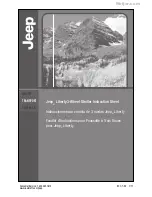
Manual 2100-746D
Page
58 of 59
Ventilation Alarm
This alarm indicates that the Vent inputs have continuity. The function
of the device connected to the Vent inputs should be verified first. If all
device functionality is correct and the alarm is still present the wiring
between the device and controller should be checked. Prior to replacing the
I/O board all wiring should be removed from the Vent inputs. This should
clear the alarm if the board and software are functioning properly.
Power Loss Alarm (Units 1-6)
This alarm indicates that control voltage (24vac) is not detected for the
unit indicted. Voltage should be verified at R-C for the unit specified. If
not present wiring and control voltage at the unit should be verified. If
18-24vac is present at R-C for the unit indicated the I/O board may be
damaged.
Compressor Lockout Alarm (Units 1-6)
This alarm indicates that the LOR inputs for the unit indicated have
continuity. The function of the device connected to the LOR inputs should
be verified first. If all device functionality is correct and the alarm is still
present the wiring between the device and controller should be checked.
Prior to replacing the I/O board all wiring should be removed from the
LOR inputs. This should clear the alarm if the board and software are
functioning properly.
HVAC Dust Alarm (Units 1-6)
This alarm indicates that the Dust inputs for the unit indicated have
continuity. The function of the device connected to the Dust inputs should
be verified first. If all device functionality is correct and the alarm is still
present the wiring between the device and controller should be checked.
Prior to replacing the I/O board all wiring should be removed from the
Dust inputs. This should clear the alarm if the board and software are
functioning properly.
Hum/Temp Sensor Not Connected
This alarm indicates that the HUM/TEMP sensor is not connected. The
4 pin terminal labeled HUM/TEMP should be checked to make sure it is
seated properly and continuity of wiring to sensor should be checked prior
to replacement of sensor or I/O board.
High Humidity Alarm
This alarm indicates that the space humidity has risen higher than desired.
The space humidity should be verified and compared to the controller
reading. If the space humidity reading is incorrect ensure there is no offset
applied and then the wiring to the humidity sensor should be verified. If
wiring is verified and sensor reading is still high sensor replacement may
be required. If the space humidity is proven to be higher than desired
malfunction of the dehumidification equipment or lack of dehumidification
capacity should be investigated.
Low Humidity Alarm
This alarm indicates that the space humidity is lower than desired. The
space humidity should be verified and compared to the controller reading.
If the space humidity reading is incorrect ensure there is no offset applied
and then the wiring to the humidity sensor should be verified. If wiring
is verified and sensor reading is still low then sensor replacement may
be required. If the space humidity is proven to be lower than desired
malfunction of the humidification equipment or lack of humidification
capacity should be investigated.








































